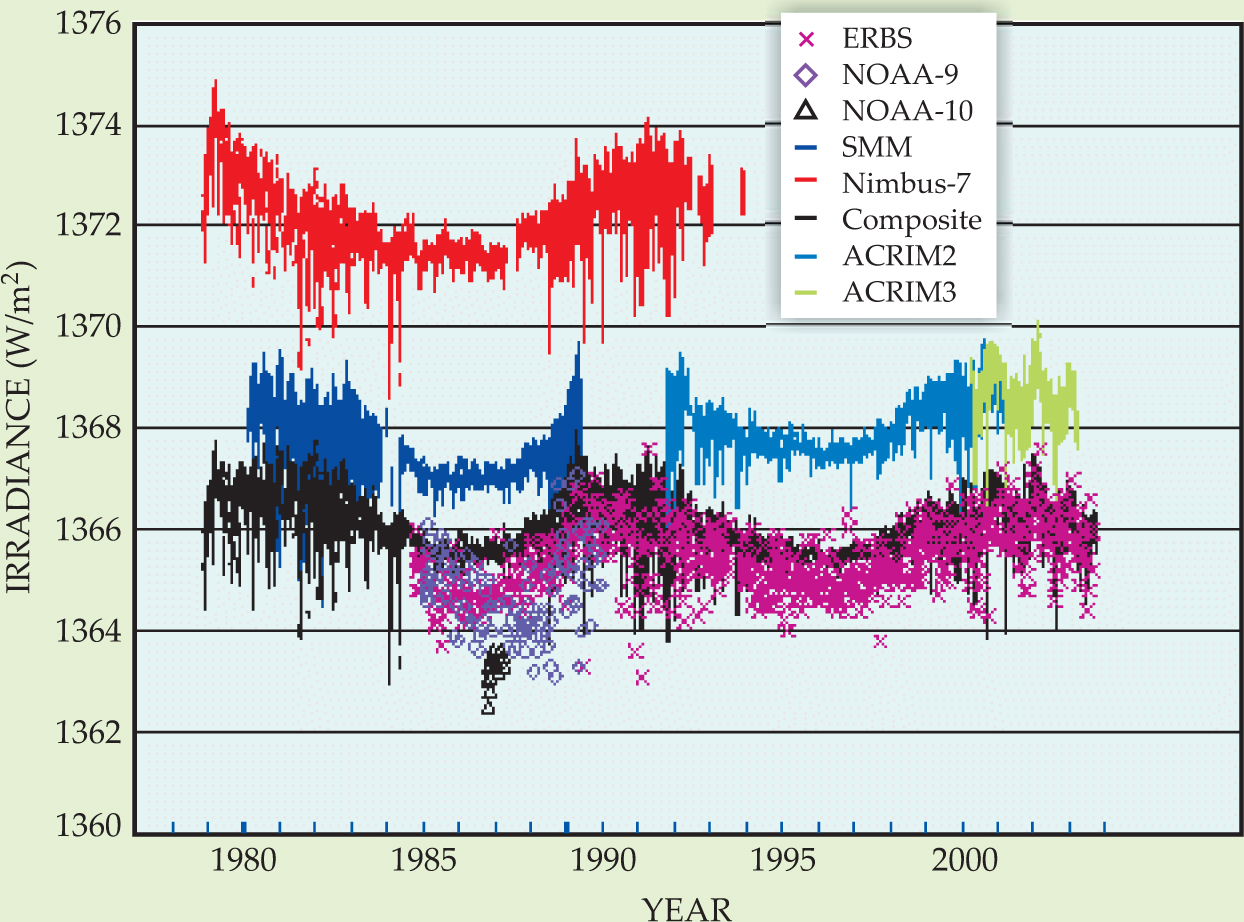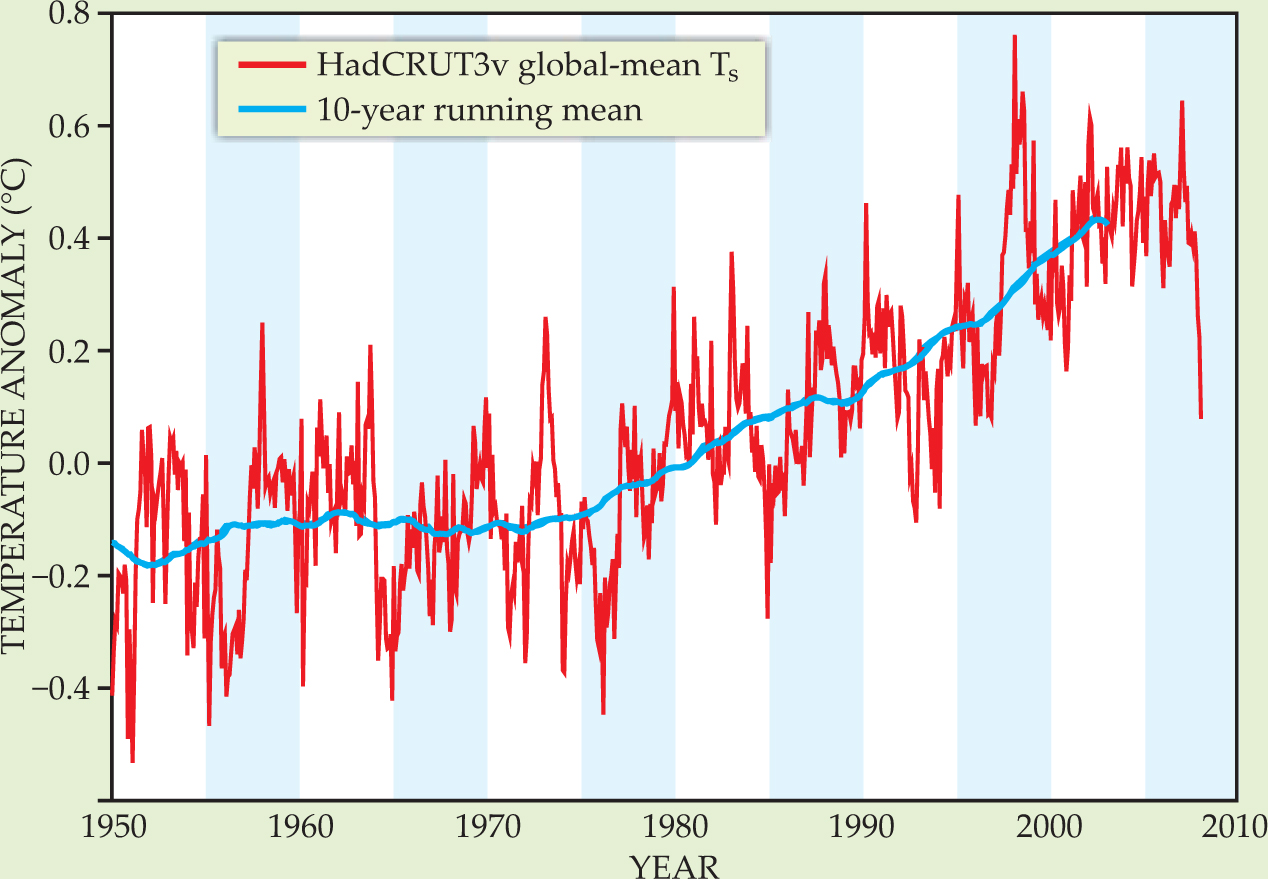Solar variability does not explain late-20th-century warming
DOI: 10.1063/1.3074263
The hypothesis of Nicola Scafetta and Bruce West (see their Opinion piece, Physics Today, March 2008, page 50
As for the 11-year cycle in TSI, satellite measurements of TSI since 1979 show variations that are very small (about 0.1%) and cyclical (see figure 1). If Earth’s surface temperature were highly sensitive to those variations, the 11-year cycle in TSI would produce an 11-year cycle in observed surface temperatures. The filtered and smoothed temperature record presented by Scafetta and West appears to show a significant 11-year cycle. However, an exhaustive analysis of the latter half of the 20th century by Gerald North and his collaborators found a temperature cycle with an amplitude of no more than a few hundredths of a degree Celsius, with a significance level of only 25%.
1
Even that small signal, which is roughly consistent with the expected signal that North and colleagues estimated using an energy-balance model, may be in part an artifact of fortuitous spacing of major volcanic eruptions (see the letter by Peter Foukal, Physics Today, October 2008, page 10

Figure 1. Satellite measurements of total solar irradiance show no increasing trend. ERBS, NOAA-9, NOAA-10, SMM, Nimbus-7, ACRIM2, and ACRIM3 are all measurements from specific satellites. The curve labeled composite is based on results from all the satellites.
(Data are from the National Oceanic and Atmospheric Administration, National Geophysical Data Center, http://www.ngdc.noaa.gov/stp/SOLAR/IRRADIANCE/irrad.html.)

Hence, the historical surface temperature record does not support the hypothesis of strong temperature sensitivity to solar irradiance changes. Additionally, that hypothesis predicts greater-than-observed temperature variations during prehistoric times (see the letter by Diedrich Schmidt, Physics Today, October 2008, page 10
In any case, as is evident from figure 1, TSI variations since 1979 are cyclical, with no discernible multi-decadal trend. Hence, the variations cannot explain the observed warming trend since 1979, which has continued over more than two 11-year cycles (see figure 2). That conclusion is supported by thorough analyses by Foukal and his collaborators 4 and by others.

Figure 2. Observed monthly global temperature anomalies since 1950. The red curve is the HadCRUT3v data set of global-mean near-surface air temperature, T s, the standard meteorological temperature measurement. The blue curve is a 10-year running mean.
(Data are from the climatic research unit, University of East Anglia, UK.)

Is it possible that TSI variations, although having little direct effect on Earth’s energy balance, nonetheless control climate by somehow regulating more energetic processes? (An analogy would be a transistor.) The “complexity matching” argument of Scafetta and West is along those lines. Their argument seems unlikely to be correct, however, since observations by Sydney Levitus and his collaborators show that the climate system as a whole, particularly the ocean, has warmed along with the atmosphere; 5 the energy content of the climate system increased between about 1955 and about 1995 by about 2 × 1023 J, equivalent to an energy imbalance at the top of the atmosphere of 0.3 W/m2. Because incoming solar energy—that is, TSI—has not changed, the imbalance must result from increased absorption of outgoing energy, such as by increased greenhouse gases. Indeed, satellite measurements by John Harries and coworkers confirm that absorption of outgoing terrestrial radiation by several greenhouse gases became stronger 6 between 1970 and 1997.
An additional failing of Scafetta and West’s hypothesis is that it requires greenhouse gases to have very little effect on surface temperatures but offers no explanation of why that might be. If, as they posit, 69% of the observed warming trend since 1950 is explained by TSI variations, then the large observed increases in greenhouse gases—which are indisputable—must have had relatively little influence on temperature. That conclusion would be impossible to reconcile with what we know about temperatures during ice ages and other paleoclimates, the climate of Venus, and many other phenomena. It also doesn’t agree with sophisticated detection and attribution studies, such as that by Gabi Hegerl and her collaborators, that convincingly show that the patterns and magnitudes of recent changes in many climate variables are consistent with a substantial and dominant forcing by greenhouse gases. 7
For example, the hypothesis of solar variability as a dominant influence on temperature fails to explain the observed cooling of the stratosphere since about 1950, as shown by David Thompson and Susan Solomon, 8 among others. That cooling is a predicted consequence of increases in well-mixed greenhouse gases and decreases in stratospheric ozone. 9 If increases in solar luminosity were the dominant forcing on climate, the troposphere and stratosphere should warm, contrary to observations.
In summary, the hypothesis of Scafetta and West—that solar variability is the dominant climate influence during the late 20th century—is a nonsolution to a nonproblem. There is no problem because the history of global temperatures during the 20th century is adequately explained by known phenomena: greenhouse gases, volcanic eruptions, aerosols, and, yes, to a small degree, solar variability. That conventional explanation is simple, self-consistent, and relies on well-established physics. The Scafetta and West hypothesis is a nonsolution because it is inconsistent with a range of observations and invokes new and unproven physics. Extraordinary claims require extraordinary proof; Scafetta and West have failed to provide it.
References
1. G. R. North, Q. Wu, M. Stevens, in Solar Variability and Its Effects on Climate, J. M. Pap, P. Fox, eds., Geophysical Monograph 141, American Geophysical Union, Washington, DC (2004), p. 251.https://doi.org/10.1029/141GM18
2. A. Bhatnagar, K. Jain, S. C. Tripathy, Astrophys. Space Sci. 281, 761 (2002).https://doi.org/10.1023/A:1016325824515
3. B. Mendoza, Astrophys. J. 483, 523 (1997).https://doi.org/10.1086/304210
4. P. Foukal, C. Fröhlich, H. Spruit, T. M. L. Wigley, Nature 443, 161 (2006).https://doi.org/10.1038/nature05072
5. S. Levitus, J. I. Antonov, T. P. Boyer, C. Stephens, Science 287, 2225 (2000).https://doi.org/10.1126/science.287.5461.2225
6. J. E. Harries, H. E. Brindley, P. J. Sagoo, R. J. Bantges, Nature 410, 355 (2001).https://doi.org/10.1038/35066553
7. G. C. Hegerl et al., in Climate Change 2007: The Physical Science Basis, S. Solomon et al., eds., Cambridge U. Press, New York (2007), p. 663.
8. D. W. J. Thompson, S. Solomon, J. Climate 18, 4785 (2005).https://doi.org/10.1175/JCLI3585.1
9. B. D. Santer et al., Science 300, 1280 (2003).https://doi.org/10.1126/science.1082393
More about the Authors
Philip Duffy is scientific director in the Palo Alto, California, office and a senior research scientist at Climate Central Inc. Benjamin Santer is a physicist in the program for climate model diagnosis and intercomparison at Lawrence Livermore National Laboratory in Livermore, California. Tom Wigley is a senior scientist at the National Center for Atmospheric Research in Boulder, Colorado.
Philip B. Duffy. 1Palo Alto, California, US .
Benjamin D. Santer. 2 Lawrence Livermore National Laboratory, Livermore, California, US .
Tom M. L. Wigley. 3 National Center for Atmospheric Research, Boulder, Colorado, US .
